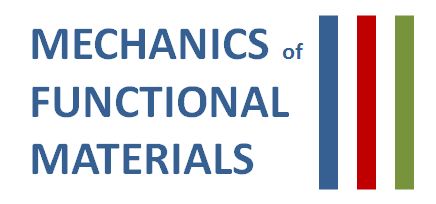-
![]() Picture: Jingwei Xiang
Picture: Jingwei Xiang![]() Picture: Jingwei Xiang
Picture: Jingwei XiangA study of gradient strengthening based on a finite-deformation gradient crystal-plasticity model
2017/07/22
New Publication in “Continuum Mechanics and Thermodynamics”
A comprehensive study on a finite-deformation gradient crystal-plasticity model which has been derived based on Gurtin’s framework is carried out here. This systematic investigation on the different roles of governing components of the model represents the strength of this framework in the prediction of a wide range of hardening behaviors as well as rate-dependent and scalevariation responses in a single crystal. …
-
![]()
![]()
Multiscale Examination of Strain Effects in Nd-Fe-B Permanent Magnets
2017/07/12
New Publication in “Physical Review Applied”
We perform a combined first-principles and micromagnetic study on the strain effects in Nd-Fe-B permanent magnets. First-principles calculations on Nd2Fe14B reveal that magnetocrystalline anisotropy (K) is insensitive to deformation along the c axis, and that a-b in-plane shrinkage is responsible for K reduction. The predicted K is more sensitive to lattice deformation than the previous phenomenological model suggests. …
-
![]() Picture: Michael Duerrschnabel
Picture: Michael Duerrschnabel![]() Picture: Michael Duerrschnabel
Picture: Michael DuerrschnabelAtomic structure and domain wall pinning in samarium-cobalt-based permanent magnets
2017/07/04
New Publication in “Nature Communications”
A higher saturation magnetization obtained by an increased iron content is essential for yielding larger energy products in rare-earth Sm2Co17-type pinning-controlled permanent magnets. Here we present model magnets with an increased iron content based on a unique nanostructure and -chemical modification route using Fe, Cu, and Zr as dopants. …
-
![]()
![]()
Visit of Prof. Sarbajit Banerjee's Group From Texas A&M University, USA
2017/06/26
Prof. Sarbajit Banerjee and his colleagues visited our group from June 25th to 29th, 2017. Prof. Banerjee also gave a presentation at the colloquium of the department on June 26th, 2017. We had an intense discussion about the coorperation of the modeling and experiments on the intelligent and energy materials.
-
![]() Picture: Peter Stein
Picture: Peter Stein![]() Picture: Peter Stein
Picture: Peter SteinA model for diffusion and immobilization of Lithium in SiOC nanocomposite anodes
2017/06/07
New Publication in JOM
In order to simulate the diffusion of Li ions in SiOC nanocomposites, we developed a reaction-diffusion model for multiphase materials. This model extends existing models for single-phase diffusion through consideration of the ion transport across material interfaces. …
-
![]()
![]()
TU Darmstadt Day at Tongji University, Shanghai – Workshop Functional Materials
2017/05/19
The event TU Darmstadt Day at Tongji University took place in Shanghai successfully on 19.05.2017. In the framework of TU Darmstadt Day, the bilateral workshop of Functional Materials also took place, colleagues have exchanged their current research results and discussed the possible future steps of research and collaboration in the field of materials science.
-
![]() Picture: Habib Pouriayevali
Picture: Habib Pouriayevali![]() Picture: Habib Pouriayevali
Picture: Habib PouriayevaliDecomposition of Dislocation Densities at Grain Boundary in a Finite-Deformation Gradient Crystal-Plasticity Framework
2017/04/21
New Publication in the “International Journal of Plasticity”
The microscopically powerless boundaries are studied based on a finite-deformation gradient crystal-plasticity model which comprises energetic and dissipative governing components. The innovative feature in the present study includes a decomposition of dislocation densities at the boundary which provides a distinct observation of dislocation transmission through the boundary.
-
![]()
![]()
Variational boundary conditions based on the Nitsche method for fitted and unfitted isogeometric discretizations of the mechanically coupled Cahn-Hilliard equation
2017/04/07
New Publication in the “Journal of Computational Physics”
The primal variational formulation of the fourth-order Cahn–Hilliard equation requires C1-continuous finite element discretizations, e.g., in the context of isogeometric analysis. In this paper, we explore the variational imposition of essential boundary conditions that arise from the thermodynamic derivation of the Cahn–Hilliard equation in primal variables.
-
Enhanced electrocaloric effect near polymorphic phase boundary in lead-free potassium sodium niobate ceramics
2017/03/16
New Publication in “Applied Physics Letters”
The electrocaloric (EC) effect in lead-free (1-x)(K0.48Na0.52)(Nb0.95Sb0.05)O3-xBi0.5(Na0.82K0.18)0.5ZrO3 ceramics was investigated using an indirect thermodynamic method. Large EC temperature changes were obtained in the vicinity of a polymorphic phase boundary at 40 kV/cm, e.g., 0.32 K at 359 K for x = 0.03, 0.51 K at 350 K for x = 0.04, and 0.48 K at 300 K for x = 0.05, respectively.
-
![]()
![]()
Winter school “Modeling of Functional Materials” in the framework of DFG-FOR 1509 “Ferroic functional materials”
2017/02/25
In the framework of Research Unit FOR 1509 “ Ferroic Functional Materials – Multiscale Modeling and Experimental Characterization ” funded by the German Science Foundation, the winter school Modeling of Functional Materials was held successfully at Chalet Giersch of TU Darmstadt from February 19 to 25, 2017.
Division Mechanics of Functional Materials
News Archive
Archive






















